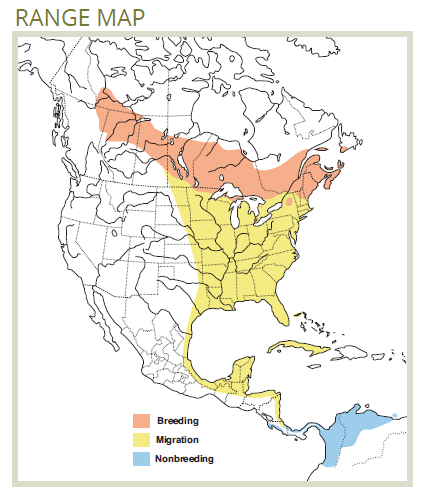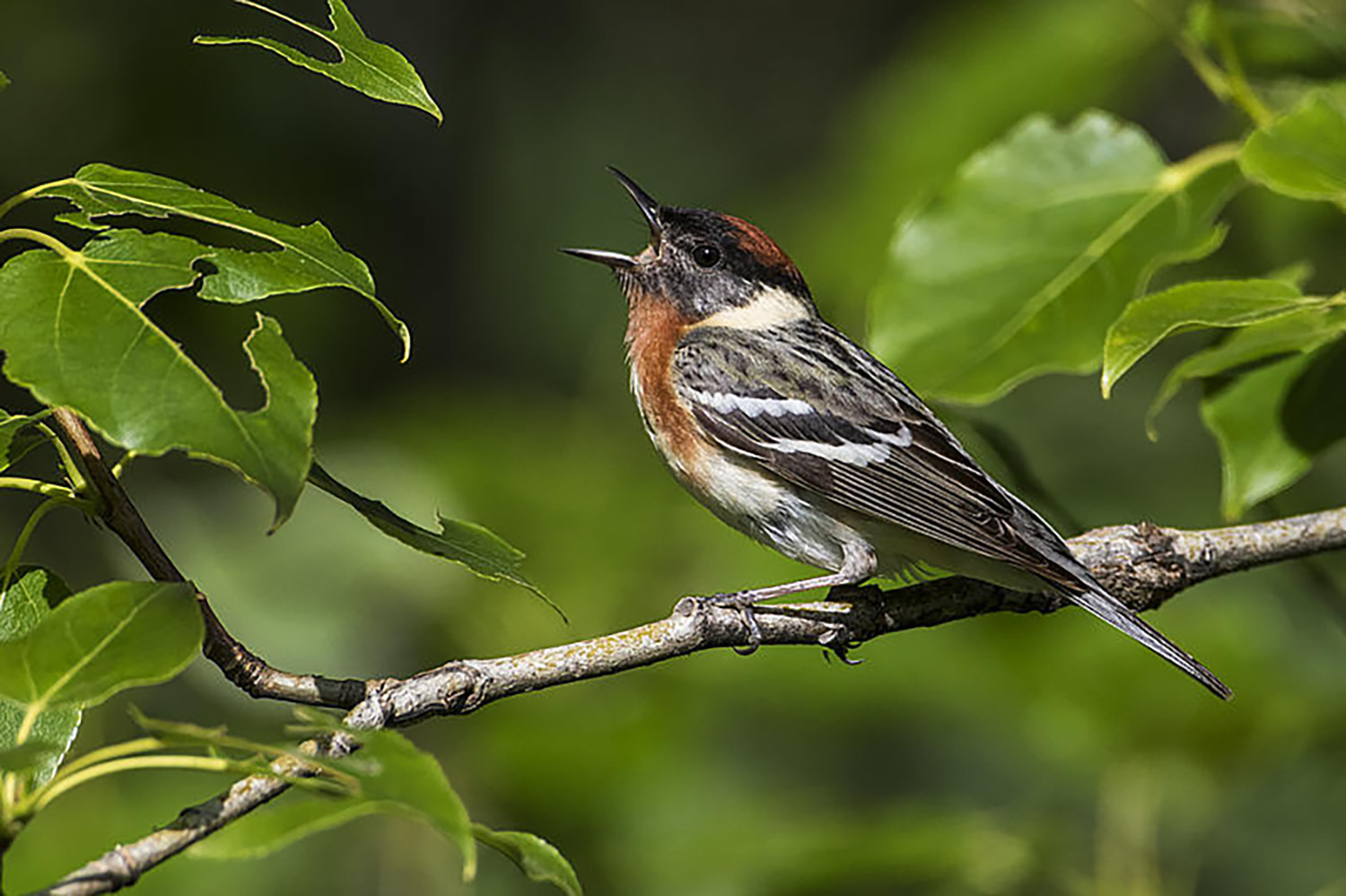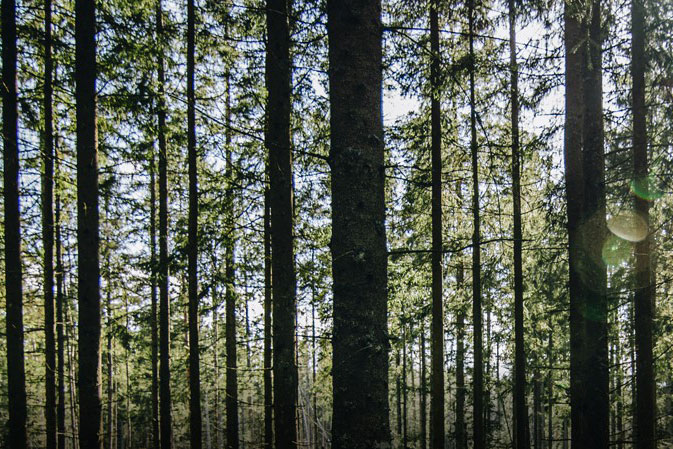This beautiful warbler has a high-pitched, inconspicuous song, making it a difficult species to study. A spruce budworm specialist, its population booms during budworm outbreaks.
Bay-breasted Warbler
(Setophaga castanea)
Habitat Ecology
- Bay-breasted Warblers breed in old white spruce, balsam fir and mixedwood stands.1,2 In Saskatchewan, they are most abundant in very old (>140 years) forest.3
- They are often found near water4 and will use riparian corridors.5
- This species is a spruce budworm specialist: populations will increase greatly during outbreaks, and they may spill over into younger-than-usual habitats due to the abundance of food.4
- Bay-breasted Warblers nest mainly in the canopy of spruce or fir trees. Nest height varies widely (1–20 m recorded), but average nest height values range from 4.5–7.5 m.4

Response to Forest Management
- Bay-breasted Warblers depend almost exclusively on old, unharvested forests during the breeding season.6
- They were unlikely to be present in clearcut (i.e. no planned retention) stands up to 33 years postharvest.7
- They are sensitive to removal or fragmentation of old forests. They were absent from 100-ha landscapes with <55% forest cover in Quebec,8 and even wide riparian buffers are not considered quality breeding habitat.4
- However, mid-seral (30–50-year) harvest-origin (i.e., planted) conifer stands may be suitable habitat.9
Stand-level Recommendations
- Retention areas (e.g., Wildlife Tree Areas and Wildlife Habitat Areas in BC) are recommended in areas of high habitat quality where larger-scale deferments are not feasible. While they are expected to provide important habitat features as the forest regenerates, they are not expected to match the habitat quality of larger unharvested areas, and their value to breeding pairs needs further research.5
- Retention areas (e.g., Wildlife Tree Areas in BC) >5 ha, containing >80 year-old white spruce with dead lower branches and shrubby understory, are recommended within managed areas.5
- Larger unharvested areas of at least 10–30 ha are recommended within areas of very high habitat quality (e.g., white spruce >100–140 years with signs of declining health).5
- While direct observations are low due to low population densities, this species is considered unlikely to benefit from dispersed retention levels <40%, based on responses of other forest specialist species.6
Landscape-level Recommendations
- Large white spruce forests past the rotation age are considered the most important tool for forest managers.8
- Bay-breasted Warblers are most likely to occur in areas with a high proportion of older forest within 50 ha,6 and old forest areas >100 ha are considered optimal habitat for this species.10 Natural range of variation analyses can be used to plan for supply of these large, unfragmented habitats on the landscape.11
- These large, old forests and/or set-asides are also likely to benefit Cape May Warbler, and should preferentially include sites containing spruce >140 years old to maximize these co-benefits.5
References
- Environment Canada. 2013. Bird Conservation Strategy for Bird Conservation Region 6: Boreal Taiga Plains. Canadian Wildlife Service, Environment Canada, Edmonton, Alberta. 288 pp.
- Schieck, J. & Song, S. J. 2006. Changes in bird communities throughout succession following fire and harvest in boreal forests of western North America: literature review and meta-analyses. Canadian Journal of Forest Research 36: 1299–1318. Available online: https://doi.org/10.1139/x06-017
- Cumming, E. E. & Diamond, A. W. 2002. Songbird community composition versus forest rotation age in Saskatchewan boreal mixedwood forest. The Canadian Field-Naturalist 116: 69–75. Available online: http://www.biodiversitylibrary.org/item/109250
- Venier, L., Holmes, S. & Williams, J. M. 2011. Bay-breasted Warbler (Setophaga castanea), version 2.0. in The Birds of North America (Rodewald, P. G., ed.) Cornell Lab of Ornithology, Ithaca, New York, USA. Available online: https://doi.org/10.2173/bna.206
- Cooper, J. M. & Beauchesne, S. M. 2004. Bay-breasted Warbler. in Accounts and Measures for Managing Identified Wildlife (Version 2004) Biodiversity Branch, Identified Wildlife Management Strategy, Victoria, BC. Available online: http://www.env.gov.bc.ca/wld/frpa/iwms/documents/Birds/b_baybreastedwarb…
- Norton, M. R. 2001. Status of the Bay-breasted Warbler (Dendroica castanea) in Alberta. Alberta Environment, Fisheries and Wildlife Management Division, and Alberta Conservation Association, Wildlife Status Report No. 32, Edmonton, AB. 21 pp.
- Leston, L., Bayne, E. & Schmiegelow, F. 2018. Long-term changes in boreal forest occupancy within regenerating harvest units. Forest Ecology and Management 421: 40–53. Available online: https://doi.org/10.1016/j.foreco.2018.02.029
- Drolet, B., Desrochers, A. & Fortin, M.-J. 1999. Effects of Landscape Structure on Nesting Songbird Distribution in a Harvested Boreal Forest. The Condor 101: 699–704.
- Thompson, I. D., Kirk, D. A. & Jastrebski, C. 2013. Does postharvest silviculture improve convergence of avian communities in managed and old-growth boreal forests? Canada Journal of Forest Research 43: 1050–1062. Available online: https://doi.org/10.1139/cjfr-2013-0104
- Alberta Environment and Sustainable Resource Development. 2014. Black-Throated Green Warbler, Bay-Breasted Warbler and Cape May Warbler Conservation Management Plan 2014-2019. Alberta Environment and Sustainable Resource Development. Species at Risk Conservation Management Plan No. 10, Edmonton, AB. 33 pp.
- Bonar, R. 2018. Personal communication. April 6, 2018








